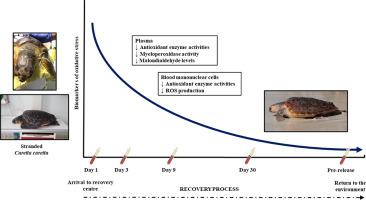Science of the Total Environment ( IF 9.8 ) Pub Date : 2020-12-03 , DOI: 10.1016/j.scitotenv.2020.143930 Samuel Pinya , Emanuela Renga , Gloria Fernández , Guillem Mateu-Vicens , Silvia Tejada , Xavier Capó , Antoni Sureda

|
The loggerhead turtle, Caretta caretta, is a very vulnerable species to human action which means that numerous specimens arrive at the recovery centres to be treated until they can be returned to the natural environment. The aim of the present study was to investigate the physiological evolution of C. caretta specimens that have entered a recovery centre by using oxidative stress biomarkers. Plasma and peripheral blood mononuclear cells of specimens were obtained at different periods: the day of arrival at the recovery centre (day 1), at 3, 9, and 30 days later, and a final sample collected before the animal was returned to the sea. The average residence time in the centre until the return to the sea was 58.5±6.1 days. The activities of antioxidant enzymes - catalase (CAT), superoxide dismutase (SOD), glutathione reductase, and glutathione peroxidase activities in immune cells and CAT and SOD in plasma - progressively decreased throughout the recovery time. Similarly, H2O2 production by immune cells after lipopolysaccharide (LPS) and zymosan activation progressively decreased with the recovery process. Also, malondialdehyde (MDA), as a marker of lipid peroxidation, and the activity of the pro-oxidant myeloperoxidase were significantly decreased throughout the recovery process. In conclusion, the results evidenced that the turtles presented a high level of oxidative stress upon arrival at the recovery centre, which was normalized along with their rehabilitation. Oxidative stress biomarkers are a good tool to monitor the recovery process in C. caretta complementary to the veterinary control.
中文翻译:

(Caretta caretta)中的生理生物标志物作为监测海洋恢复中心卫生演变的工具。
龟(Caretta caretta)是人类活动中非常脆弱的物种,这意味着许多标本到达恢复中心进行处理,直到它们可以返回自然环境为止。本研究的目的是研究C. caretta的生理进化通过使用氧化应激生物标记物进入恢复中心的标本。在不同时期获得标本的血浆和外周血单核细胞:到达恢复中心的当天(第1天),3、9和30天后,以及在动物返回海中之前收集的最终样本。直到返回大海,在中心的平均停留时间为58.5±6.1天。免疫细胞中抗氧化酶的活性-过氧化氢酶(CAT),超氧化物歧化酶(SOD),谷胱甘肽还原酶和谷胱甘肽过氧化物酶活性以及血浆中的CAT和SOD-在整个恢复时间内逐渐降低。同样,H 2 O 2脂多糖(LPS)和酵母聚糖激活后免疫细胞的生产随着恢复过程而逐渐降低。此外,在整个恢复过程中,丙二醛(MDA)作为脂质过氧化的标志物和促氧化剂髓过氧化物酶的活性均显着降低。总之,研究结果表明,乌龟到达恢复中心时会表现出较高的氧化应激水平,并且随着康复而恢复正常。氧化应激生物标志物是监测胡萝卜角斑病恢复过程的良好工具,与兽医控制相辅相成。



























 京公网安备 11010802027423号
京公网安备 11010802027423号